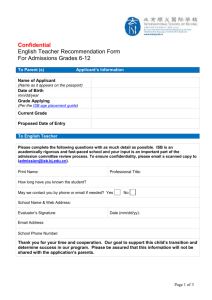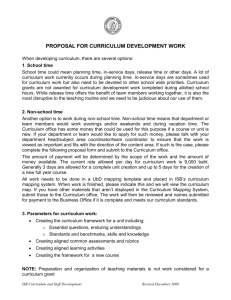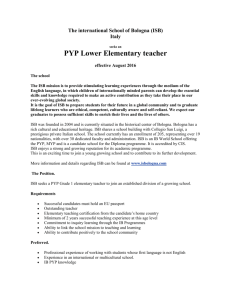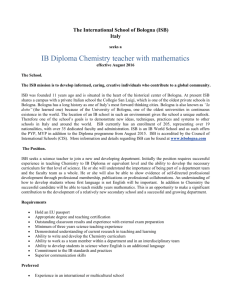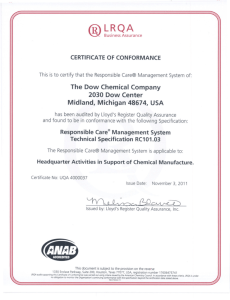ISB 1596 Secure Email Specification Amendment History
advertisement
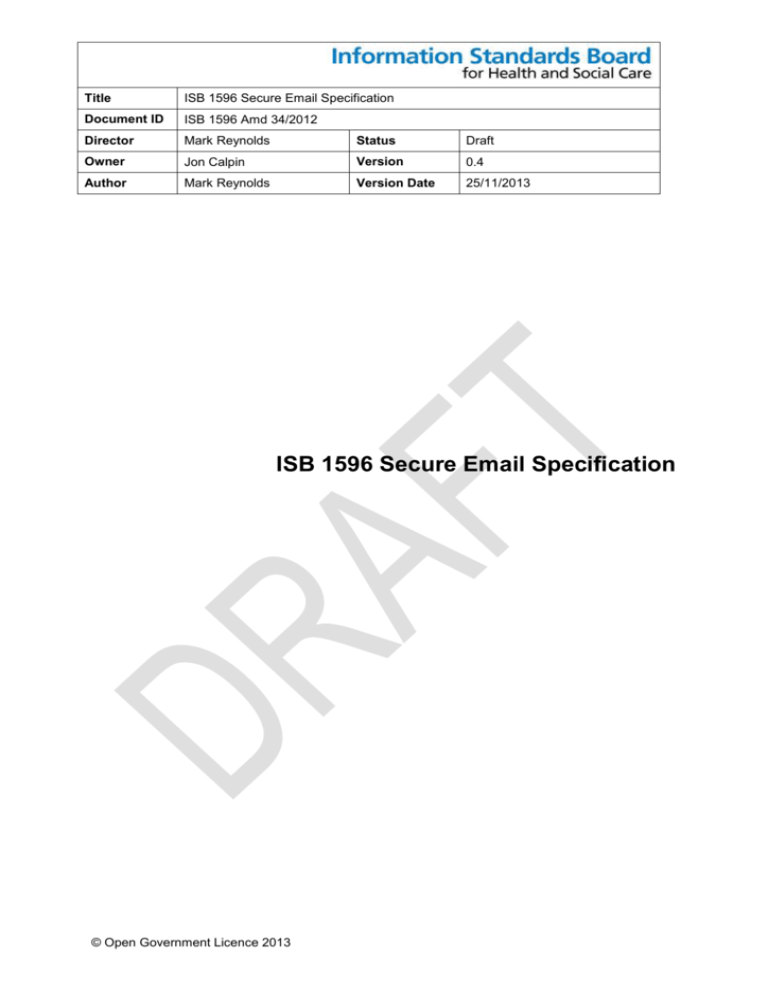
Title ISB 1596 Secure Email Specification Document ID ISB 1596 Amd 34/2012 Director Mark Reynolds Status Draft Owner Jon Calpin Version 0.4 Author Mark Reynolds Version Date 25/11/2013 ISB 1596 Secure Email Specification © Open Government Licence 2013 ISB 1596 Secure Email Specification 25/11/2013 Draft v0.4 Amendment History: Version Date Amendment History 0.2 09/09/2013 0.3 11/11/2013 Incorporates comments from ISB quality checks. 0.4 25/11/2013 Incorporates comments from ISB quality checks. Approvals: Name Title / Responsibility Dr Simon Eccles SRO – NHSmail 2 Date Version 25/11/2013 0.4 Glossary of Terms: Term Acronym Definition Business Impact Level B-IL A B-IL is a level from 1 to 6 that indicates the security risk of an IT system. It is defined by CESG guidance. CESG CESG protects the vital interests of the UK by providing policy and assistance on the security of communications and electronic data, working in partnership with industry and academia. It is the UK Government's National Technical Authority for Information Assurance (IA). CESG Listed Adviser Scheme CLAS Department of Health DH Health & Social Care Information Centre HSCIC Information Commissioner’s Office ICO The UK’s independent authority set up to uphold information rights in the public interest, promoting openness by public bodies and data privacy for individuals. Information Security Management System ISMS An information security management system (ISMS) is a set of policies concerned with information security management or IT related risks. The idioms arose primarily out of BS 7799. The governing principle behind an ISMS is that an organization should design, implement and maintain a coherent set of policies, processes and systems to manage risks to its information assets, thus ensuring acceptable levels of information security risk. © Open Government Licence 2013 Page 2 of 18 ISB 1596 Secure Email Specification 25/11/2013 Draft v0.4 Contents 1 2 3 4 5 6 7 Overview .............................................................................................................4 1.1 Summary ....................................................................................................... 4 1.2 Controlled Documents ................................................................................... 4 1.3 Guidance ....................................................................................................... 4 1.4 Related Standards ......................................................................................... 4 Introduction..........................................................................................................6 2.1 Purpose ......................................................................................................... 6 2.2 Scope ............................................................................................................ 6 2.3 Customer Need ............................................................................................. 6 Health and Care Organisations ...........................................................................7 3.1 Overview ....................................................................................................... 7 3.2 Requirements ................................................................................................ 7 3.3 Conformance ................................................................................................. 8 IT Systems Suppliers...........................................................................................9 4.1 Overview ....................................................................................................... 9 4.2 Requirements ................................................................................................ 9 4.3 Conformance ............................................................................................... 10 Technical Guidance ...........................................................................................11 5.1 Information Security .................................................................................... 11 5.2 Clinical Safety.............................................................................................. 11 5.3 Interoperability ............................................................................................. 11 User Guidance ..................................................................................................12 6.1 Emailing Patients ......................................................................................... 12 6.2 Secure Communications ............................................................................. 12 6.3 Professional Record-keeping ...................................................................... 12 6.4 Data Protection & Freedom of Information .................................................. 12 6.5 GP Practice Staff ......................................................................................... 12 Appendix 1 – Example Risk Log ........................................................................14 7.1 Overview ..................................................................................................... 14 7.2 Hazard Log .................................................................................................. 15 © Open Government Licence 2013 Page 3 of 18 ISB 1596 Secure Email Specification 25/11/2013 Draft 0.3 1 Overview 1.1 Summary Standard Standard Number ISB 1596 Secure Email Title Type Fundamental Description This standard defines the minimum non-functional requirements for a secure email service, covering the storage and transmission of email. This is the basic level for the storage and transmission of patient identifiable data by an email system. It excludes security standards for document archives. Applies to Health, public health and social care organisations. Email service providers. Release Release Number Amd 34/2012 Title Initial Standard Description 30th June 2016 Implementation Completion Date 1.2 Controlled Documents Ref no A Title Version ISB 1596 Secure Email Baseline Control Set 1.3 Guidance Ref no Title Version 1 Information: To Share Or Not To Share? The Information Governance Review 2 CIO Council Offshoring Position 1.0 3 CESG IS1 Technical Risk Assessment 3.51 4 The Good Practice Guidelines for GP electronic patient records 4 5 General Medical Council Good Medical Practice 2013 1.4 Related Standards Reference Title ISB 0086 Information Governance Toolkit © Open Government Licence 2013 Page 4 of 18 ISB 1596 Secure Email Specification 25/11/2013 Draft 0.3 ISB 0160 Clinical Risk Management: its Application in the Deployment and Use of Health IT Systems ISB 0129 Clinical Risk Management: its Application in the Manufacture of Health IT Systems BS ISO/IEC 27001: 2013 Information technology -- Security techniques -- Information security management systems -- Requirements BS ISO/IEC 27002: 2013 Information technology. Security techniques. Code of practice for information security controls IS1 HMG Impact Assessment Standards including CESG IS1 Technical Risk Assessment © Open Government Licence 2013 Page 5 of 18 ISB 1596 Secure Email Specification 25/11/2013 Draft 0.3 2 Introduction 2.1 Purpose This standard establishes the minimum requirements for email systems in health, public health and social care. The intention is not to impose significant requirements on organisations but instead to establish the minimum acceptable level. Where possible they will refer to health and care, Government and international standards (e.g. BS ISO/IEC 27001 – see related standards). 2.2 Scope The standard defines how email systems used for sensitive data (e.g. patient identifiable data) should manage: The information security of the email service. Transfer of sensitive information over non-secure channels. Accessing information from the Internet or mobile devices. Exchange of information outside the controlled boundary of the secure email system: o to other email systems compliant with this standard. o to other email systems not compliant with this standard. 2.3 Customer Need Health and care email is now a rich source of patient/service user information. There is a clear need to ensure that it is held securely and used appropriately. The power of information: putting all of us in control of the health and care information we need paragraph 3.51 specifies (our bold text): All e-mail communication about our care must be appropriately secure and protected. Work will continue to improve access to and use of NHSmail within the NHS, and social enterprises and other qualified providers of care services, as part of their commissioning contracts with the NHS, will be given access to a limited number of NHSmail accounts. Similar incentives for social care will be made available that make the process and cost of connecting social care providers, local authorities and other care providers via secure electronic communication easier, cheaper and less bureaucratic. The standard will ensure that health, public health and adult social care organisations have a recognisable baseline which they can conform to. © Open Government Licence 2013 Page 6 of 18 ISB 1596 Secure Email Specification 25/11/2013 Draft 0.3 3 Health and Care Organisations 3.1 Overview ISB 0086 Information Governance Toolkit IGT (as an already approved information standard) provides the strategic assurance tool for use by health and care organisations and other business partners / suppliers. It has a series of requirements that all health and care organisations must meet, with the information security requirements being particularly applicable. This standard describes how health and care organisations can comply with the IG Toolkit with respect to email services. Of particular note are: Num Description 10-300 The Information Governance agenda is supported by adequate information security skills, knowledge and experience which meet the organisation’s assessed needs 10-305 Operating and application information systems (under the organisation’s control) support appropriate access control functionality and documented and managed access rights are in place for all users of these systems 10-308 All transfers of hardcopy and digital person identifiable and sensitive information have been identified, mapped and risk assessed; technical and organisational measures adequately secure these transfers 10-313 Policy and procedures are in place to ensure that Information Communication Technology (ICT) networks operate securely 10-314 Policy and procedures ensure that mobile computing and teleworking are secure 10-323 All information assets that hold, or are, personal data are protected by appropriate organisational and technical measures 3.2 Requirements # Description Information Security 1 Health and care organisations MUST perform a security risk assessment when procuring or delivering an email service internally. 2 Health and care organisations MUST operate their email service to a level appropriate to the security risk assessment, and at minimum BS ISO/IEC 27001. 3 Health and care organisations MUST ensure their email service meets the baseline control set specific in Section 5.1 for Personal Data if the service contains patient identifiable or sensitive data. 4 Health and care organisations SHOULD set policies and procedures for the use of secure email using mobile devices and ensure the email service enforces them. © Open Government Licence 2013 Page 7 of 18 ISB 1596 Secure Email Specification 25/11/2013 Draft 0.3 Safety 5 Health and care organisations SHOULD comply with the provisions of ISB 0160 Clinical Risk Management: its Application in the Deployment and Use of Health IT Systems. Interoperability 6 Health and care organisations SHOULD provide updates to the NHSmail white pages directory service of their directory information. 7 Health and care organisations MUST ensure there are appropriate policies in place for the user of email, including correspondence with insecure email systems, including those used by patients. 3.3 Conformance Conformance to the security requirements shall be measured by having: An auditable information security management system in relation to the email service that conforms to BS ISO/IEC 27001. Evidence their email service either has: o Non-Personal data - a BS ISO/IEC 27001 conformance certificate with the appropriate scope of applicability and baseline control set for the service or pan-government or government departmental (e.g. Department of Health) to business impact level (B-IL) 2 or above. o Personal Data – pan government or government departmental (e.g. Department of Health) accreditation to business impact level (B-IL) 3. Conformance to the clinical safety requirements shall be met as per ISB 0160 Clinical Risk Management: its Application in the Deployment and Use of Health IT Systems. Health and care organisations shall self-certify to the interoperability requirements. © Open Government Licence 2013 Page 8 of 18 ISB 1596 Secure Email Specification 25/11/2013 Draft 0.3 4 IT Systems Suppliers 4.1 Overview IT systems suppliers need to ensure that their email service meets the needs of health and care, especially when it is used for the transmission of patient identifiable data. Email systems are not normally sector specific (i.e. just for healthcare) so IT suppliers will normally demonstrate this through adherence to cross-public sector, UK or international standards. 4.2 Requirements # Requirement Information Security 1 Each Supplier MUST at all times maintain a secure service. 2 Each Supplier MUST maintain an Information Security Management System (ISMS) that conforms to the BS ISO/IEC 27001: 2013 Information Security Management Systems baseline control set and BS ISO/IEC 27002: 2013 Information technology. Security techniques. Code of practice for information security controls. Conformance may be evidenced by appropriate certification. 3 Each Supplier MUST maintain a security policy which sets out the security measures to be implemented and maintained in accordance with BS ISO/IEC 27001, BS ISO/IEC 27002 and the Information Security Management System. The security policy MUST be reviewed and updated in a timely fashion and will be reviewed on an annual basis. 4 Each Supplier MUST ensure their email service meets the baseline control set specific in Section 5.1 for Personal Data if the service contains patient identifiable or sensitive data. 5 Each Supplier MUST conduct tests of the security policy in accordance with the provisions of the Suppliers Security Policy relating to security testing. The tests must be independently audited by either an accredited 3rd party or representatives of the customer. 6 Either party (Supplier and customer) MUST notify the other immediately upon becoming aware of any breach of security, including an actual, potential or attempted breach of, or threat to, the security policy and/or the security of the services or the systems used to provide the services. 7 Each supplier MUST provide protection against malicious content for their services such as virus checking when onboarding data. 8 The email service MUST provide anti-virus and anti-spam filtering. In addition to commodity content management such as attachment blocking, virus/spam filtering capabilities and data leakage prevention e.g. encrypt protectively marked email destined for the Internet. The service SHOULD also provide for the management of spoofed/forged email and items that cannot be checked such as S/MIME encrypted or password protected attachments. 9 All patient identifiable and sensitive data MUST at all times remain in the UK. 10 The Supplier MUST ensure that mobile devices are appropriately secured when accessing the email service. This could include: Functions to allow/deny/quarantine by device type, organisation or groups of users. Remove device, expire password, and wipe any data associated with the service. Reporting functions/ capabilities. © Open Government Licence 2013 Page 9 of 18 ISB 1596 Secure Email Specification 11 25/11/2013 Draft 0.3 Detect and block rooted (i.e. jail broken) devices. Each Supplier SHOULD provide eDiscovery tools to support the administration of the service, especially with respect of the Data Protection Act 1998 and Freedom of Information Act 2000. Safety 12 Suppliers SHOULD comply with the provisions of ISB 0129 Clinical Risk Management: its Application in the Manufacture of Health IT Systems. Interoperability 13 Each Supplier SHOUD comply with the open standards policy: 14 Each supplier SHOULD interface with the NHSmail white pages directory service and provide regular updates of NHS directory information. 4.3 Conformance Conformance to the security requirements shall be measured by: An independently audited information security management system in relation to the email service. This shall be evidenced by either a BS ISO/IEC 27001 conformance certificate for the service with the appropriate scope of applicability. BS ISO/IEC 27001 conformance certificates shall be issued from a body accredited by an appropriate National Authority. In the UK this is the United Kingdom Accreditation Service (UKAS). Evidence their email service either has: o Non-Personal data - a BS ISO/IEC 27001 conformance certificate with the appropriate scope of applicability and baseline control set for the service or pan-government or government departmental (e.g. DH or HSCIC) to business impact level (B-IL) 2 or above. o Personal Data – pan government or government departmental (e.g. DH or HSCIC) accreditation to business impact level (B-IL) 3. Conformance to the clinical safety requirements shall be met as per ISB 0129 Clinical Risk Management: its Application in the Manufacture of Health IT Systems. IT systems suppliers shall self-certify to the interoperability requirements. © Open Government Licence 2013 Page 10 of 18 ISB 1596 Secure Email Specification 25/11/2013 Draft 0.3 5 Technical Guidance 5.1 Information Security BS ISO/IEC 27001 sets out the requirements for an Information Security Management System (ISMS). This is a structured means of managing information security risk within an organisation. The CESG IS1/IS2 baseline control set provides the minimum baseline controls organisations and their IT systems must comply with. It is divided into different areas of security controls with three levels for each – DETER, DETECT AND RESIST and DEFEND. Further guidance is available on the CESG website or an appropriately accredited (CLAS) security professional. The spread sheet (A) ISB 1596 Secure Email Baseline Control Set provides the baseline control set for email services using Personal Data and non-Personal Data. 5.2 Clinical Safety Any IT system used for clinical purposes should follow the clinical safety information standards. An example risk log is provided in section 7. 5.3 Interoperability Systems should conform to open standard for interoperability, normally promulgated by the W3C. Government open standards are published on data.gov.uk. Systems should populate national directory services. Details of how to populate the NHSmail directory are available from feedback@nhs.net. © Open Government Licence 2013 Page 11 of 18 ISB 1596 Secure Email Specification 25/11/2013 Draft 0.3 6 User Guidance 6.1 Emailing Patients The (1) Caldicott 2 review noted the belief that email could not be used to communicate with patients as it is not secure. The review report noted: “The Review Panel concludes that personal confidential data can be shared with individuals via email when the individual has explicitly consented and they have been informed of any potential risk.” Health and care organisations should develop guidelines for health and care professionals to support and encourage the use of email with patients. The (5) The Good Practice Guidelines for GP electronic patient records describe the use of email for patient consultations. 6.2 Secure Communications NHS information security guidelines require that patient identifiable or sensitive data is handled appropriately. For routine communication this should be within a secure email service, or sent in a secure manner, for example encrypted attachments that comply with the NHS encryption requirements. Note that security should not be used as a reason for providing poor care. The onus is to provide appropriate systems and so share information, not inhibit it. 6.3 Professional Record-keeping In (5) Good Medical Practice (2013), the General Medical Council (GMC) states that “19. Documents you make (including clinical records) to formally record your work must be clear, accurate and legible. You should make records at the same time as the events you are recording or as soon as possible afterwards. 20. You must keep records that contain personal information about patients, colleagues or others securely, and in line with any data protection requirements” Although ephemeral in nature, emails can form part of the clinical record. Good practice is to ensure that emails are copied into the patient’s medical record. See the Medical Protection Society Good Records advice for further information. 6.4 Data Protection & Freedom of Information Information stored in an email service is subject to data protection and freedom of information requests. All health and care professionals must be aware of this obligation and support such requests. 6.5 GP Practice Staff The (5) The Good Practice Guidelines for GP electronic patient records describe the use of email in practice, noting that. © Open Government Licence 2013 Page 12 of 18 ISB 1596 Secure Email Specification 25/11/2013 Draft 0.3 “Unless practices have the technical expertise to set up and maintain a local mail server, and ensure that it is secure within the practice network boundaries, the recommended approach is to use NHSmail for this purpose. NHSmail is available in Scotland and England. © Open Government Licence 2013 Page 13 of 18 ISB 1596 Secure Email Specification 25/11/2013 Draft 0.3 7 Appendix 1 – Example Risk Log 7.1 Overview The example risk log has been derived from secure email clinical risk assurance undertaken by the HSCIC. A fishbone diagram providing an overview is given below. Secure Email Hazard Overview Attachments Assurance IT Operations File size Number of simultaneous attachments Incorrect Format Viruses Corruption Notification Failure Inadequate Backup/ Archive Inadequate failover process Inadequate rollback process Disk space Security Receipt failure Delay in transit Insufficient testing timeframe Inadequate regression testing Lack of assurance within test strategy Deployment Secure email system Desktop/Client Poorly configured infrastructure Old/Legacy systems Incompatible Operating Systems Set up/Migration done incorrectly Exceed local desktop session limit © Open Government Licence 2013 Miss-use IG non-compliance Consent Hacking Internal fraud Browsing Unauthorised access Network issues LAN issues Firewall/Routing issues Interoperability Training Insufficient Training – inappropriate usage Page 14 of 18 ISB 1596 Secure Email Specification 25/11/2013 Draft 0.3 7.2 Hazard Log Area Hazard Name Description Effect Rating File attachment issues File attachments exceed mail system specified limits. File attachments exceed mail system specified attachment quantity limits. Incorrect file formats used when attached to email. Delay to email transmission. Potential system error resulting from oversize file attachments. Failure to transmit / receive email successfully including potential loss of data. Potential system error resulting from large quantities of file attachments. Low Email notifications fail to arrive Failure to receive email notification of error message. The sender does not receive notification of email failure. Potential delay in treatment by way of failure to receive / send email. Low File Attachments Corrupt file attachments File attachment contains corrupt data undetected at source. Inadequate validation on corrupt data files or email content results in loss of data or potential corruption of recipient systems. Low File Attachments - files contain software virus File attachment or email content contains virus. Potential partial or complete system failure. Loss of data at source or recipient systems. Potential loss of service. Low Loss or inadequate backup and / or archiving processes/systems. Failure to run backup process. Potential loss of service resulting from erroneous recovery points. Lack of recovery position leads to loss of data. Low IT operations IT Operations Inadequate Backup / Archive Process / System Insufficient IT operational procedures covering failover and recovery positions. System does not failover into a known stable state. Potential loss of service and data resultant. Low IT operations IT Operations Inadequate Failover procedures Inadequate process / system configuration to allow secure email solution to recover to a known stable system state. At the point of error the email system cannot rollback to baseline configuration leading to potential unstable state, loss of service/data. Low IT operations IT Operations Inadequate Rollback process IT Operations Insufficient Disk Space Lack of hardware storage used at any point within the secure email system where temporary or permanent data is required. Email system performance issues due to inefficient storage loads. Low Attachment Attachment Attachment Attachment IT operations © Open Government Licence 2013 Page 15 of 18 ISB 1596 Secure Email Specification Area 25/11/2013 Draft 0.3 Hazard Name Description Effect Document Archive Chosen mail solution used as a document archive at Local Level. Potential loss of service and / or data due to inadequate storage facilities. Security procedures and / or configuration is not fit for purpose of email system proposed usage. Low IT operations Potential security breaches leading to unauthorised access to personal identifiable data, and commercially sensitive information. System is vulnerable to security attacks variable in nature - causing system failure, loss of data, and other business critical failures. IT Operations - Email Receipt notification fails to arrive Secure mail system fails to provide receipt during email transmission process. Low IT operations Failure to receive receipt notifications could lead to resubmissions throughout the email transmission process. This would in turn increase messaging volumes and increase the potential for delays in system performance. IT Operations - Delays in end to end processing of email Email system and / or performance issues lead to significant delays in transmission at any point within the email pathway to recipient. Deployment Network Issues on deployment Deployment of secure email results in network failures / issues at local or national levels, local network, or LAN performance and / or availability issues. Deployment Deployment of email system - Leading to Firewall / Routing issues Deployment and configuration of firewall / routing infrastructure fails to complete successfully. Deployment Deployment of email system - Leading to 'Clash' of Software Tools Deployment of email system leads to conflicts with existing system software. Potential performance issues with conflicting systems. Low Desktop/Client Desktop / Client - Inadequate / poorly configured desktop and Inability to standardise and deploy email system. Low IT Operations Insufficient Security compliance IT operations © Open Government Licence 2013 Potential loss / delay of service. Potential loss of data. Network availability restrictions result in limited business functionality. Potential issues leading to the mail solution impacting user base day to day system performance and availability. Restriction in messaging routing. Complete loss of service due to incorrect configuration of firewalls. Page 16 of 18 Rating Low Low Low ISB 1596 Secure Email Specification Area 25/11/2013 Draft 0.3 Hazard Name Description Effect Badly Configured client infrastructure. Desktop / Client - "Old" Target desktop and client systems are outside the baseline limitations and recommendations for email usage. Increased volumes of helpdesk requests on non standard hardware. Inability to install email system on non supported hardware. Inadequate system performance leading to complete system failure. Potential loss of existing business processes. Desktop/Client Desktop / Client Unsuitable Windows versions Existing operating system is outside the baseline supported configuration. Inability to install email system on target hardware. Poor configuration leading to operational issues and increased helpdesk calls. Potential inefficient email service levels. Low Desktop/Client Desktop / Client – Setup / Migration wrong Email service setup and migration fails to complete successfully on target system. Potential performance issues with poorly configured systems. Loss of data due to incorrectly setup storage and archiving facilities. Low Desktop/Client Desktop / Client Local Connectivity Issues Local System issues lead to inability to connect to the email service Potential performance issues leading to complete loss of service. Low Desktop/Client Desktop / Client - Too many windows open Large number of local desktop sessions exceeds 'normal' expected operational levels. Email system connectivity issues and performance issues due to increases processing constraints. Email system used inappropriately, contravening IG security controls / guides. Potential breach in IG policies/controls lead to source email information compromise. Breaches in security protocol and local / national policies for mail usage. Potential to misuse system not having appropriate access/training leading to severe email issues. Misuse Misuse - IG / Unauthorised Access Misuse Misuse – Consent Inappropriate use of mail system without expressed consent of data source or system authorities. Potential breaches of information sharing and overall system usage. Misuse Misuse – Hacking Email system is targeted by external or internal hacking or attempts to connect in a manner not permitted by existing Inappropriate access to email system data, personal identifiable or business critical information. Critical misuse implications if undetected - complete © Open Government Licence 2013 Email system operation by end user who does not have access or approval to use the system. Page 17 of 18 Rating Low Low Low Low ISB 1596 Secure Email Specification Area Description Effect IG/security controls. loss of service, data tampering, etc. Misuse - Internal Fraud Existing authorised user attempts to fraudulently operate email system Internal Fraud covers various targets for misuse and may lead to inappropriate email usage, authorisation messages, and potential access to business or personally critical systems. Low Misuse Misuse – Browsing Inappropriate use of email system resulting in browsing of group/personal mail accounts. Access to information outside of normal controls for end users. Potential conflicts of business operation due to inappropriate data access, security breaches, etc. Low Migration Data Migration Errors / poor quality Migration of legacy or existing email data. Data Migration of legacy or email records Low Functionality New Functionality Additional features of new email system / New functionality introduce issues with current service and / or existing functionality provided. Training Inadequate Training Poor Quality Training on the new system leads to inappropriate email use. Potential data loss. Potential inappropriate email usage based on 'not enough' or ineffective training. Test Strategy and scope does not fully assure the release of the new system Potential loss / delay of service. Potential loss of data. Misuse Assurance/ Testing Hazard Name 25/11/2013 Draft 0.3 Limited Test Assurance Potential loss / delay of service. Potential loss of data. Inadequate regression test assurance of existing / unchanged functionality. Low Low Low Insufficient Testing timeframe. © Open Government Licence 2013 Rating Page 18 of 18
